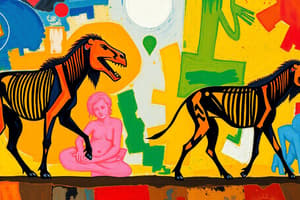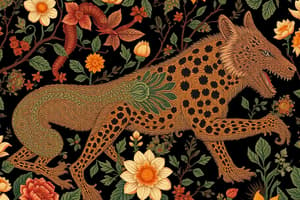Podcast
Questions and Answers
What is the main concept Darwin's Theory of Evolution is based on?
What is the main concept Darwin's Theory of Evolution is based on?
- Fossil collection
- Artificial selection
- Changes in living organisms over time (correct)
- Voyage of the Beagle
Which of the following best describes a scientific theory?
Which of the following best describes a scientific theory?
- Purely subjective belief
- Well-supported testable explanation (correct)
- Unproven idea
- Random guess
Why did Darwin visit Argentina and Australia during his voyage?
Why did Darwin visit Argentina and Australia during his voyage?
- To find evidence supporting his current beliefs
- To promote artificial selection
- To study similar grassland ecosystems with different animal populations (correct)
- To collect fossils of ancient organisms
What kind of animals did Darwin find in Argentina and Australia's similar grassland ecosystems?
What kind of animals did Darwin find in Argentina and Australia's similar grassland ecosystems?
What inspired Darwin to propose his revolutionary hypothesis about life changes over time?
What inspired Darwin to propose his revolutionary hypothesis about life changes over time?
Which of the following best explains why there were no kangaroos in England according to Darwin?
Which of the following best explains why there were no kangaroos in England according to Darwin?
'Why had so many of these species disappeared?' What question is Darwin referring to in this context?
'Why had so many of these species disappeared?' What question is Darwin referring to in this context?
'Why were there no rabbits in Australia?' What does this question signify in Darwin's observations?
'Why were there no rabbits in Australia?' What does this question signify in Darwin's observations?
'How were they related to living species?' What aspect was Darwin primarily interested in with this question?
'How were they related to living species?' What aspect was Darwin primarily interested in with this question?
'Others looked completely unlike any creature he had ever seen.' How did this observation influence Darwin's thinking?
'Others looked completely unlike any creature he had ever seen.' How did this observation influence Darwin's thinking?
Flashcards are hidden until you start studying
Study Notes
Lamarck's Theory of Evolution
- The theory proposes a "Tendency toward Perfection", where species develop towards perfection over time, e.g. the giraffe's neck.
- Use and Disuse concept: as birds use their forearms, they develop stronger arms.
- Inheritance of Acquired Traits: species pass on characteristics acquired through use or disuse to their offspring.
Population Growth and Malthus
- Thomas Malthus, a 19th-century English economist, proposed that population growth is limited by insufficient living space and food resources.
- If population grows rapidly, and more babies are born than die, it leads to resource scarcity.
Publication of Origin of Species
- Russell Wallace wrote an essay summarizing evolutionary changes from his field work in Malaysia, prompting Darwin to publish his findings.
- Darwin applied Malthus' theory to animals in his book "On the Origin of Species".
Natural Selection and Artificial Selection
- Natural variation: individuals of a species exhibit differences.
- Artificial selection: humans select and breed organisms with desired traits, enhancing those variations.
- Natural selection results from the struggle for existence, where individuals better suited to their environment survive and reproduce, passing on advantageous traits.
Evolution by Natural Selection
- Over time, natural selection leads to changes in inherited characteristics, increasing a species' fitness in its environment.
- Descent with modification: each living organism has descended with changes from other species over time through common ancestors.
Evidence of Evolution
The Fossil Record
- Fossils show changes in species over time, with transitional forms between ancient and modern species.
Geographic Distribution of Living Things
- Similar environments have similar types of organisms, indicating evolutionary adaptation to specific habitats.
Homologous Body Structures
- Structures with different mature forms in different organisms develop from the same embryonic tissue, indicating a common ancestor.
Similarities in Early Development
- Embryos of different species exhibit similar developmental stages, indicating a shared evolutionary history.
Vestigial Organs
- Organs that serve no useful function in an organism, e.g., the appendix, indicate evolutionary remnants from ancestors.
Summary of Darwin's Theory
- Individuals in nature differ from one another.
- Organisms produce more offspring than can survive, and many non-reproducing individuals do not pass on their traits.
Studying That Suits You
Use AI to generate personalized quizzes and flashcards to suit your learning preferences.




